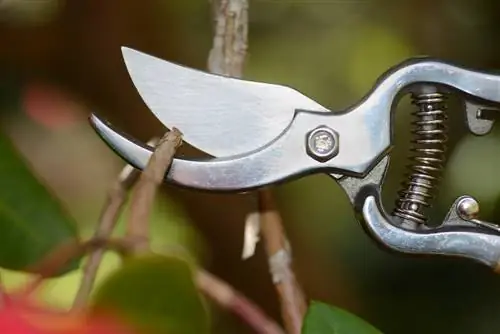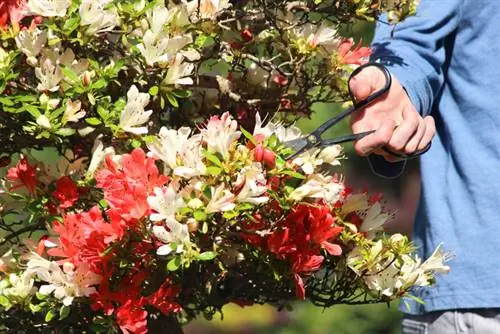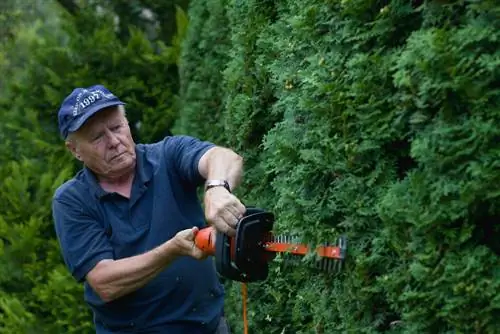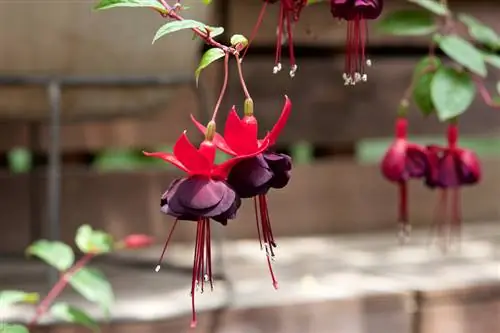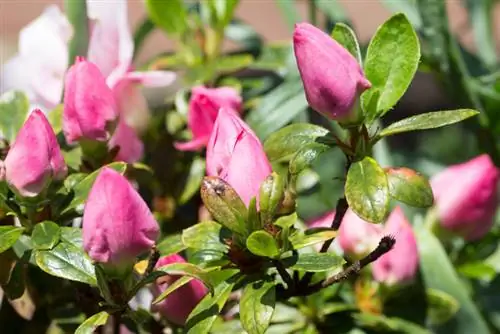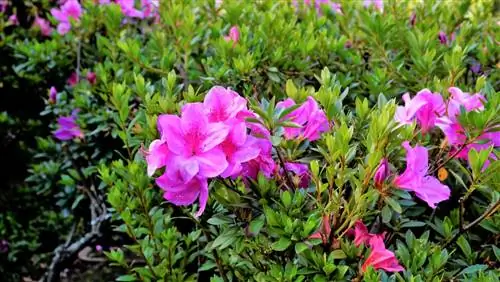- Author admin [email protected].
- Public 2023-12-16 16:46.
- Last modified 2025-06-01 06:02.
When azaleas appear in bog beds or pots, pruning care is a headache for many gardeners. This tutorial strives to remove all gardening stumbling blocks. Find out here when and how to cut alpine roses correctly.

When and how do you prune azaleas correctly?
Azaleas should be cut in the spring before budding, although a topiary can be carried out from the 5th year onwards if necessary. Rejuvenation cut for baldness. Always cut into 5 cm small cones. Clean out wilted flowers annually.
Occasions for an azalea cut
Azaleas are typical spring bloomers that produce their thick flower buds in the summer of the previous year. The ornamental shrubs are characterized by a stable framework that forms without any horticultural intervention. A build-up cut is therefore not part of the cut care. As long as an alpine rose thrives compactly and with lots of flowers, it does not need regular pruning, apart from annual flower care. The following table summarizes the conditions under which azaleas should still be cut:
| Cut option | Target | Period/Occasion |
|---|---|---|
| Breaking Out Withered | Formation of new flower buds for next year | every year |
| Topiary | prune shoots that protrude out of shape | if necessary, not before the 5th year |
| Rejuvenation cut | Resolve baldness, promote flowering | with progressive baldness on old bushes |
When is the best time?
Azaleas produce their buds after the flowering period. This growth behavior leaves little scope for a pruning date. To shorten individual shoots or rejuvenate the ornamental shrub, choose a mild day in spring before budding. Depending on the variety, fresh shoots often only appear at the interface after a year or later. In gardening practice it has been found that pruning dates in autumn or winter are punished with a total failure of the pruned shoots or the entire alpine rose. Only flower care takes place in June, immediately after the end of the flowering period.
Cleaning out wilted things properly - this is how it works
Scissors and saws stay in the tool shed for annual flower care on azaleas. When the floral spring fairy tale comes to an end, the first buds are already waiting beneath the withered flowers. You already have the necessary tools with you in the form of your fingers. How to properly clean out faded azaleas:
- Grasp the short piece of shoot below a withered flower between your index finger and thumb
- Break away or snip off the dead inflorescence to the side
As the illustration below shows, bud bases, leaves or shoots located below the withered inflorescences should not be damaged. The sooner you clean out everything that has faded on your azaleas, the easier it will be.
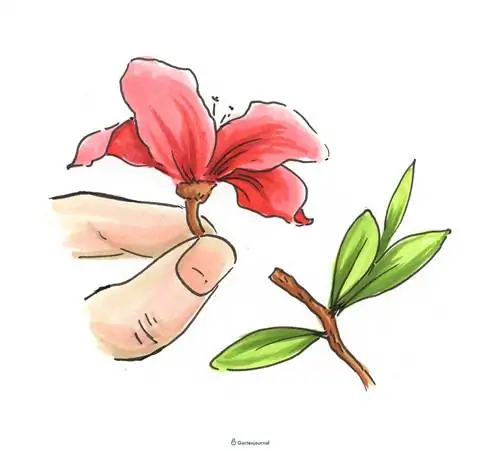
Withered azalea flowers are broken off or snapped off with the fingertips. This clears the way for buds that have already been planted for the next flowering period.
Cut azaleas optionally - instructions for topiary
It happens that individual branches become bare or protrude from the azalea bush and make it appear sparse. Cut these shoots back in spring so that the cut does not leave a gap that will only close after years. How to do it right:
- Cut azalea branches back to a 4-5 centimeter small cone with a side leaf
- Result: Leaf nourishes the cone so that it doesn't dry out
- Ideal result: new growth begins in the following year
If you only notice disturbing shoots in the middle of the flowering period, you can still prune them at a later date. The image below illustrates the cutting process. The prerequisite for success is that you cut on a cone with a side leaf and that it is a single branch.
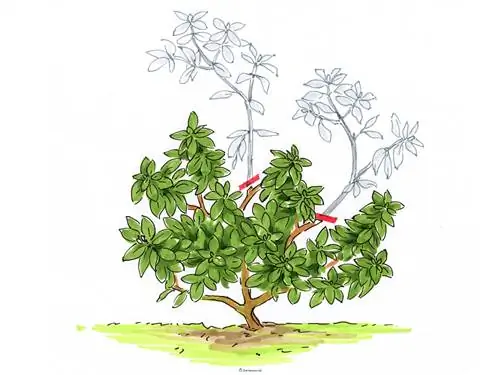
If branches that are too long disrupt the harmonious shape, shorten the shoots before flowering. Leave a small cone with a leaf on the side to encourage new growth.
Fix baldness with a rejuvenating cut - this is how it works
Azaleas grow compact and full of flowers for many years. However, as they get older they can form gaps and become bald from below. That is no reason to clear a formerly busy blooming alpine rose. With a rejuvenating cut you can effectively stimulate leaf growth and flowering performance. By spreading the radical pruning measure over several stages, you reduce the stress on an old azalea. How to proceed correctly step by step:
- First stage: Half of all senescent shoots lead to a branch inside the bush
- Second stage: Second half of the shoots also divert to a deeper branch
The image below illustrates the correct cut. Place the saw at a fork so that a 5 centimeter long peg remains. In contrast to the topiary, there is no leaf at this point to supply the tenon. The new growth can therefore take some time. Therefore, give a rejuvenated azalea a helping hand with an extra portion of fertilizer. A special fertilizer NPK 14+7+14 for rhododendrons is well suited for a vital growth momentum. Distribute 100 grams per square meter, water generously and cover the fertilizer with a 3 centimeter high layer of rhododendron soil or ericaceous bed substrate.
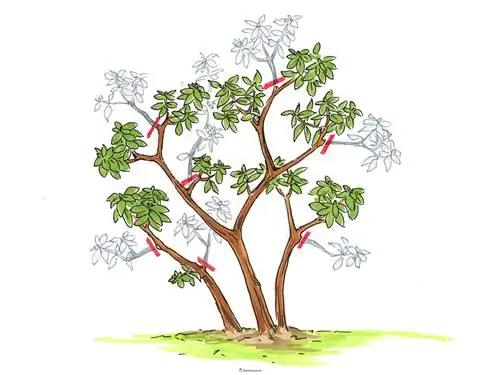
A bare azalea is rejuvenated in two stages. In February of the first year, half of all shoots are diverted onto a branch with a small cone. In February of the second year, the other half of the bush is rejuvenated. In the summer of the third year, the new shoots of the cones stop. Dried cone residue can be removed.
Cutting with tenons - how to do it right
In the tutorial, the special cutting technique that is crucial for azaleas is pointed out at an appropriate point. The cut with a small cone and side shoot is rare in tree care. As a general rule, prune your shrubs and treetops a short distance to a bud or branch to maintain vitality and prevent infection. Therefore, the tutorial at this point is once again dedicated in detail to the correct pruning when making shape and rejuvenation cuts on azaleas. How to do it right:
- When cutting in the leafy shoot area: place the scissors at a distance of 5 centimeters from a side leaf
- When cutting in the bare branch area: position the saw 5 centimeters away from a branch
- Leave the cones until the new shoots are strong enough
The cones dry back over time. If the dried tissue does not fall off on its own, you can remove the withered pieces.
Tips for the right tools
The right tools are one of the key factors for successful azalea pruning. The right scissors and saw should be ready to hand for every size and type of cut. When purchasing, make sure it is of good quality so that you can handle the cutting tool comfortably and easily take it apart for care and cleaning work. Although most azalea varieties remain small and reach a maximum height of 150 centimeters, thick branches can form over time. The following equipment for pruning care is recommended:
- Knives with a straight blade or hip with a curved edge
- Hand scissors for all branches up to 2 cm thick
- Pruning shears for shoots with a diameter of 2 to 4 cm
- Sword or hacksaw for branches from 4 cm
Don't be confused by the extensive range of models when purchasing, but instead use the variety to choose the perfect tool for your individual needs. Scissors are available for left- and right-handed people, large and small hands, and with bypass or anvil mechanics.
In our opinion, bypass shears are more suitable for cutting azaleas because they work with two sharp blades so that shoots cannot be crushed. We also advocate sword saws because they leave smooth wound edges. Pruning shears are only important if you are cultivating a variety of the azalea species Rhododendron luteum. In the ideal location, this can be as high as a man, so the longer reach of a pruning shear is an advantage and makes climbing on the ladder unnecessary.
Prepare the cutting tool - this is what you should pay attention to
Before each cut, check whether the scissor gear is working. There should be no play in the blades and anvil. If necessary, tighten the locking screw that high-quality scissors have. It is important to note that you only work with sharp blades and saw blades. Blunt tools cause frayed wound edges, which are an ideal target for pathogens and pests. You can sharpen scissor blades yourself or have them sharpened by a specialist. Dull saw blades need to be replaced, so a spare blade should be kept on hand.
Meticulous cleanliness is also important for expert azalea pruning. Clean your tools after each use. Before the next cut, disinfect blades and saw blades with high-percentage alcohol. One of the most common causes of the spread of diseases and pests is contaminated cutting tools.
Frequently asked questions
What is the difference between azaleas and rhododendrons?
From a botanical point of view, the species and varieties of azaleas belong to the rhododendron genus. This fact is expressed in the botanical names. This is what botanists call the Japanese azalea Rhododendron japonicum. The outstanding difference is that azaleas thrive as deciduous or at least semi-evergreen shrubs, whereas rhododendrons wear their leaves all year round. Visually, garden azaleas differ from rhododendrons in their brighter flower colors and upright, tighter growth.
Do azaleas need pruning after transplanting?
No, in contrast to most garden plants, azaleas are not cut back after a change of location. Like all rhododendron species, azaleas do not exert the necessary root pressure after transplanting to re-sprout from old wood. To ensure that the flowering bushes regenerate quickly, choose a date between the beginning of March and mid-May. Please make sure to dig up as much of the root volume as possible and place it in the ground at the new location.
Can the clippings be used as cuttings?
Azaleas can be easily propagated from cuttings. The chances of a successful outcome are highest between mid-July and early September, when the time window for a cut is also open. It is important to note that you cut azalea cuttings in dry weather. Head or shoot cuttings with a length of five to ten centimeters are perfect. Please use a heatable mini greenhouse and acidic, lime-free growing substrate.
Are azaleas poisonous?
All azaleas contain toxins that can cause symptoms of poisoning if consumed intentionally or unintentionally. Just one leaf, bud or flower is enough to cause cramps, nausea and vomiting in children, sensitive adults and animals. Ingestion of larger quantities may result in slowed cardiac activity, shortness of breath, coma or death. Alpine roses are not recommended for cultivation in the family garden with small children and pets.
A storm severely damaged the azalea on one side - what to do?
It is not enough to remove azaleas from one-sided damage to the undamaged areas. In order for the flowering tree to regenerate evenly after storm damage, the balance within the crown must be maintained. In technical jargon, this ideal state is referred to as the juice scale. In concrete terms, this means that the shoots on the undamaged side of the bush should be cut back just as far as on the damaged side.
Why do individual azalea buds die before the flowers develop?
This is a typical symptom of a fungal infection caused by the rhododendron leafhopper. In September, the green-orange colored females lay their eggs in the buds. During this process, the insects transmit a fungus that causes rhododendron and azalea buds to die. Cut off brown-colored, wilted buds below the first pair of leaves and dispose of the cuttings in the household waste. As a preventive measure, you can hang yellow panels in your azaleas in August and September to catch incoming cicadas.
The 3 most common cutting mistakes on azaleas
If the cut leaves an azalea that is deformed or unwilling to bloom, the gardener has made a mistake. The following table summarizes the 3 most common causes and their consequences with tips for prevention:
| Error | Result | Prevention |
|---|---|---|
| wrong cutting time | Flower failure | cut individual shoots in spring |
| no flower care | decreasing flowering ability | Clean out wilted flowers regularly |
| Shoots cut off and not derived on cones | holey, uneven growth | always derive from 5 cm small cones |

Tip
Indoor azaleas rarely please gardeners for longer than one or two winters, even under ideal conditions. Indian azaleas (Rhododendron simsii), the most common potted azaleas in garden centers, have a good chance of blooming between October and April. Ideally, indoor azaleas spend the summer in a cool, shady spot in the garden, where they are regularly watered and sprayed with soft water. The pruning care is no different from garden azaleas, except for the choice of date taking into account the winter flowering period.

